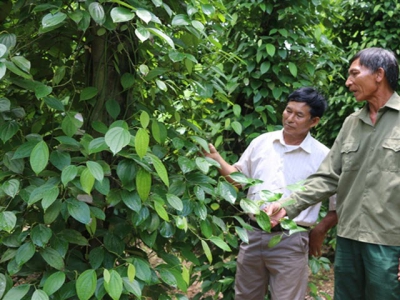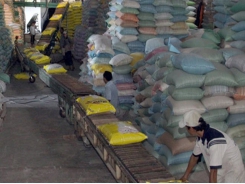Pepper farmers switch to other crops as price declines

BÌNH PHƯỚC - Many pepper farmers in the southern province of Bình Phước have switched to other crops to improve their income amid declining pepper prices and disease outbreaks.
A pepper orchard in Bình Phước Province’s Bù Đốp District. Many pepper orchards this year have produced less fruit because of inclement weather and diseases. – VNA/VNS Photo
Bình Phước Province is one of the country’s largest producers of pepper, which is a key product for the province.
Farmer Nguyễn Ngọc Tiến in Bù Đốp District’s Thiện Hưng Commune planted cashew and pepper before switching to coconut in his 2ha orchard.
Coconuts require low costs as farmers only need to buy seedlings and tend to them. The cost of fertiliser and pesticide for coconut farming is much lower than for other crops, according to Tiến.
Tiến harvests about 70-150 coconuts (used for juice) each day and earns about VNĐ1 million (US$43).
“Coconuts offer a stable and year-round income,” he said.
Besides coconuts, many farmers in Thiện Hưng have switched to sweet mandarin, green-skin and pink-flesh grapefruit and Tonkin creeper flower, a type of flower used for cooking.
Phan Đình Thoại, chairman of the Thiện Hưng Farmers Association, said that coconuts had brought stable incomes to farmers.
Diseases have affected many pepper orchards, destroying many plants. As a result, many pepper farmers have bred animals in their pepper orchards or intercropped with other crops.
Nguyễn Văn Đức, whose pepper orchard in Bù Gia Mập District died en mass early this year from disease, has earned a good income from breeding 20 goats in his orchard where acacia trees are used as pillars to grow pepper plants.
The acacia trees remain and grow well after the pepper plants die, he said. “I use acacia leaves to feed the goats."
Local authorities have also provided farmers with seedlings of other crops and fertiliser.
In Lộc Ninh District, for instance, the district’s People’s Committee has provided corn seeds and fertiliser to 22 poor households in Lộc Khánh Commune whose pepper plants died because of disease outbreaks.
Under the province’s plan to restructure agriculture launched five years ago, the province targeted 14,500ha of pepper in 2020, but its pepper farming area grew to about 17,000ha.
More pepper was planted because of the high price of pepper in recent years, according to the province’s Department of Agriculture and Rural Development.
However, disease outbreaks and declining prices have led to a reduction in pepper planting compared to last year.
The province’s People’s Committee has asked local authorities to review the pepper farming areas, especially areas that are not suitable to pepper cultivation. It has told farmers to convert 2,000ha of dead pepper plants to high-value crops.
Có thể bạn quan tâm
Phần mềm

Phối trộn thức ăn chăn nuôi

Pha dung dịch thủy canh

Định mức cho tôm ăn

Phối trộn phân bón NPK

Xác định tỷ lệ tôm sống

Chuyển đổi đơn vị phân bón

Xác định công suất sục khí

Chuyển đổi đơn vị tôm

Tính diện tích nhà kính

Tính thể tích ao hồ



 Rice exports set to reach 6.5 million tonnes…
Rice exports set to reach 6.5 million tonnes…  Rice quality key to exports
Rice quality key to exports